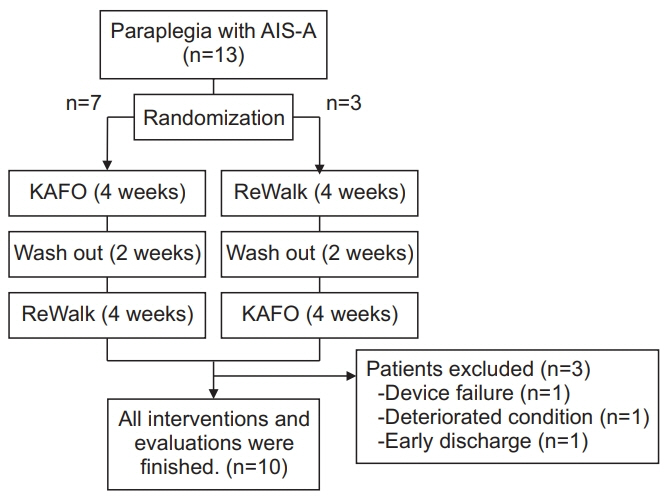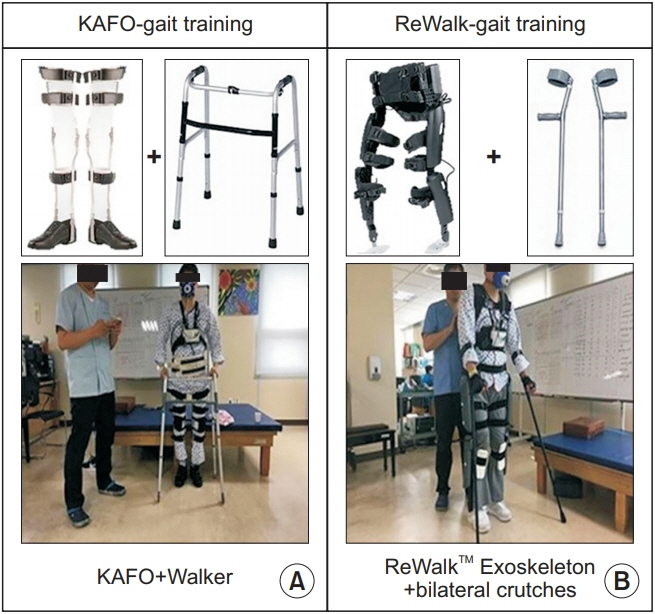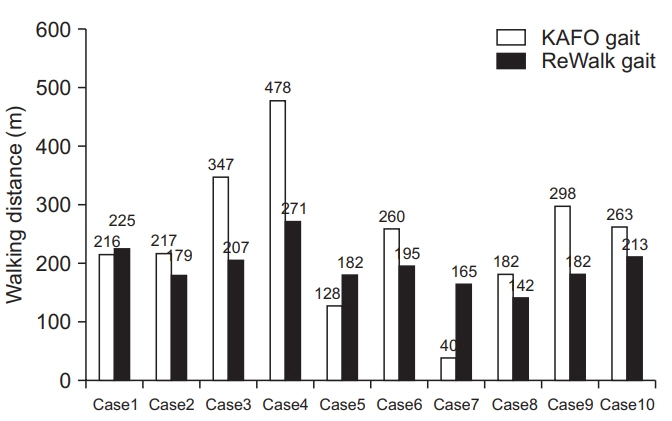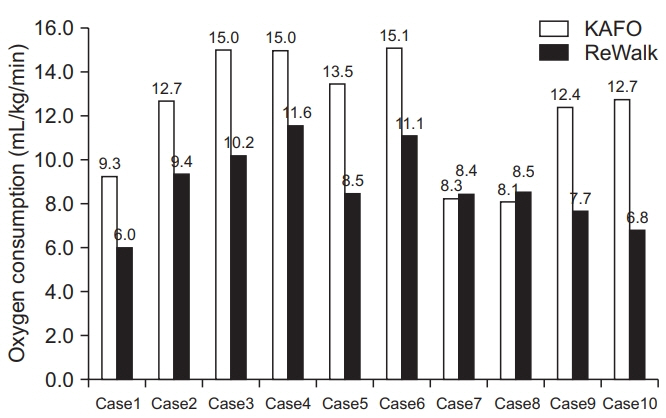Ann Rehabil Med.
2020 Apr;44(2):131-141. 10.5535/arm.2020.44.2.131.
Energy Efficiency and Patient Satisfaction of Gait With Knee-Ankle-Foot Orthosis and Robot (ReWalk)-Assisted Gait in Patients With Spinal Cord Injury
- Affiliations
-
- 1Department of Rehabilitation Medicine, National Rehabilitation Center, Seoul, Korea
- 2Department of Clinical Research on Rehabilitation, National Rehabilitation Research Institute, Seoul, Korea
- 3Department of Physical Medicine and Rehabilitation, National Rehabilitation Center, Seoul, Korea
- KMID: 2501057
- DOI: http://doi.org/10.5535/arm.2020.44.2.131
Abstract
Objective
To compare the energy efficiency of gait with knee-ankle-foot orthosis (KAFO) and robot-assisted gait and to develop a usability questionnaire to evaluate the satisfaction of walking devices in paraplegic patients with spinal cord injuries.
Methods
Thirteen patients with complete paraplegia participated and 10 completed the evaluation. They were trained to walk with KAFO (KAFO-gait) or a ReWalk robot (ReWalk-gait) for 4 weeks (20 sessions). After a 2-week wash-out period, they switched walking devices and underwent 4 additional weeks of training. Two evaluations were performed (after 2 and 4 weeks) following the training periods for each walking device, using the 6-minute walking test (6MWT) and 30-minute walking test (30MWT). The spatiotemporal variables (walking distance, velocity, and cadence) and energy expenditure (heart rate, maximal heart rate, the physiologic cost index, oxygen consumption, metabolic equivalents, and energy efficiency) were evaluated duringthe 6MWT and 30MWT. A usability evaluation questionnaire for walking devices was developed based on the International Organization for Standardization/International Electrotechnical Commission guidelines through expert consultation.
Results
The ReWalk-gait presented significant advantages in energy efficiency compared to KAFO-gait in the 6MWT and 30MWT; however, there were no differences in walking distance or speed in the 30MWT between ReWalk-gait and KAFOgait. The usability test demonstrated that ReWalk-gait was not superior to KAFO-gait in terms of safety, efficacy, efficiency, or patient satisfaction.
Conclusion
The robot (ReWalk) enabled patients with paraplegia to walk with lower energy consumption compared to KAFO, but the ReWalk-gait was not superior to KAFO-gaitin terms of patient satisfaction.
Keyword
Figure
Cited by 2 articles
-
Effects of Wearable Powered Exoskeletal Training on Functional Mobility, Physiological Health and Quality of Life in Non-ambulatory Spinal Cord Injury Patients
Hyeon Seong Kim, Jae Hyeon Park, Ho Seok Lee, Jae Young Lee, Ji Won Jung, Si-Bog Park, Dong Jin Hyun, Sangin Park, JuYoung Yoon, Hyunseop Lim, Yun Young Choi, Mi Jung Kim
J Korean Med Sci. 2021;36(12):e80. doi: 10.3346/jkms.2021.36.e80.Feasibility and Usability of a Robot-Assisted Complex Upper and Lower Limb Rehabilitation System in Patients with Stroke: A Pilot Study
Kyoung Tae Kim, Yongmin Choi, Jang Hyuk Cho, Soyoung Lee
Ann Rehabil Med. 2023;47(2):108-117. doi: 10.5535/arm.23017.
Reference
-
1. Walter JS, Sola PG, Sacks J, Lucero Y, Langbein E, Weaver F. Indications for a home standing program for individuals with spinal cord injury. J Spinal Cord Med. 1999; 22:152–8.
Article2. Kawashima N, Taguchi D, Nakazawa K, Akai M. Effect of lesion level on the orthotic gait performance in individuals with complete paraplegia. Spinal Cord. 2006; 44:487–94.
Article3. Kunkel CF, Scremin AM, Eisenberg B, Garcia JF, Roberts S, Martinez S. Effect of “standing” on spasticity, contracture, and osteoporosis in paralyzed males. Arch Phys Med Rehabil. 1993; 74:73–8.4. Guest RS, Klose KJ, Needham-Shropshire BM, Jacobs PL. Evaluation of a training program for persons with SCI paraplegia using the Parastep 1 ambulation system. Part 4: Effect on physical self-concept and depression. Arch Phys Med Rehabil. 1997; 78:804–7.5. Dijkers M. Quality of life after spinal cord injury: a meta analysis of the effects of disablement components. Spinal Cord. 1997; 35:829–40.
Article6. Waters RL, Mulroy S. The energy expenditure of normal and pathologic gait. Gait Posture. 1999; 9:207–31.
Article7. Sykes L, Campbell IG, Powell ES, Ross ER, Edwards J. Energy expenditure of walking for adult patients with spinal cord lesions using the reciprocating gait orthosis and functional electrical stimulation. Spinal Cord. 1996; 34:659–65.
Article8. Jeong WK, Lee BS, Kim YH, Kim SK, Choi YN. Standing and gait of the paraplegics by spinal cord injury after discharge. J Korean Acad Rehabil Med. 2005; 29:365–70.9. Esquenazi A, Packel A. Robotic-assisted gait training and restoration. Am J Phys Med Rehabil. 2012; 91(11 Suppl 3):S217–S231.
Article10. Esquenazi A, Talaty M, Packel A, Saulino M. The ReWalk powered exoskeleton to restore ambulatory function to individuals with thoracic-level motorcomplete spinal cord injury. Am J Phys Med Rehabil. 2012; 91:911–21.
Article11. Zeilig G, Weingarden H, Zwecker M, Dudkiewicz I, Bloch A, Esquenazi A. Safety and tolerance of the ReWalk exoskeleton suit for ambulation by people with complete spinal cord injury: a pilot study. J Spinal Cord Med. 2012; 35:96–101.12. Arazpour M, Bani MA, Hutchins SW, Jones RK. The physiological cost index of walking with mechanical and powered gait orthosis in patients with spinal cord injury. Spinal Cord. 2013; 51:356–9.
Article13. Enright PL. The six-minute walk test. Respir Care. 2003; 48:783–5.14. van Dijsseldonk RB, Rijken H, van Nes IJ, van de Meent H, Keijsers NL. A framework for measuring the progress in exoskeleton skills in people with complete spinal cord injury. Front Neurosci. 2017; 11:699.
Article15. Yang A, Asselin P, Knezevic S, Kornfeld S, Spungen AM. Assessment of in-hospital walking velocity and level of assistance in a powered exoskeleton in persons with spinal cord injury. Top Spinal Cord Inj Rehabil. 2015; 21:100–9.
Article16. Benson I, Hart K, Tussler D, van Middendorp JJ. Lower-limb exoskeletons for individuals with chronic spinal cord injury: findings from a feasibility study. Clin Rehabil. 2016; 30:73–84.
Article17. Platz T, Gillner A, Borgwaldt N, Kroll S, Roschka S. Device-training for individuals with thoracic and lumbar spinal cord injury using a powered exoskeleton for technically assisted mobility: achievements and user satisfaction. Biomed Res Int. 2016; 2016:8459018.
Article18. Spungen AM, Asselin P, Fineberg DB, Kornfeld SD, Harel NY. Exoskeletal-assisted walking for persons with motor-complete paraplegia. Brussels, Belgium: North Atlantic Treaty Organization, Science and Technology Organization;2013.19. Raab K, Krakow K, Tripp F, Jung M. Effects of training with the ReWalk exoskeleton on quality of life in incomplete spinal cord injury: a single case study. Spinal Cord Ser Cases. 2016; 2:15025.
Article20. Asselin P, Knezevic S, Kornfeld S, Cirnigliaro C, Agranova-Breyter I, Bauman WA, et al. Heart rate and oxygen demand of powered exoskeleton-assisted walking in persons with paraplegia. J Rehabil Res Dev. 2015; 52:147–58.
Article21. Karimi MT, Fatoye F. Evaluation of the performance of paraplegic subjects during walking with a new design of reciprocal gait orthosis. Disabil Rehabil Assist Technol. 2016; 11:72–9.
Article22. Yatsuya K, Hirano S, Saitoh E, Tanabe S, Tanaka H, Eguchi M, et al. Comparison of energy efficiency between Wearable Power-Assist Locomotor (WPAL) and two types of knee-ankle-foot orthoses with a medial single hip joint (MSH-KAFO). J Spinal Cord Med. 2018; 41:48–54.
Article23. Hirano S, Saitoh E, Tanabe S, Katoh M, Shimizu Y, Yatsuya K, et al. Comparison between gait-assisting robot (WPAL) and bilateral knee-ankle-foot orthoses with a medial single hip joint in gait reconstruction for patients with paraplegia. Jpn J Compr Rehabil Sci. 2015; 6:21–6.
- Full Text Links
- Actions
-
Cited
- CITED
-
- Close
- Share
- Similar articles
-
- Neuroplasticity Induced by Robot-assisted Gait Training in a Stroke Patient: A case report
- Effects of Plastic Ankle-Foot Orhtosis on Hemiplegic Ambulation
- Standing and Gait of the Paraplegics by Spinal Cord Injury after Discharge
- Effect of Plastic Ankle Foot Orthosis and Functional Electrical Stimulation on Hemiplegic Gait
- A Review of Robot-Assisted Gait Training in Stroke Patients





